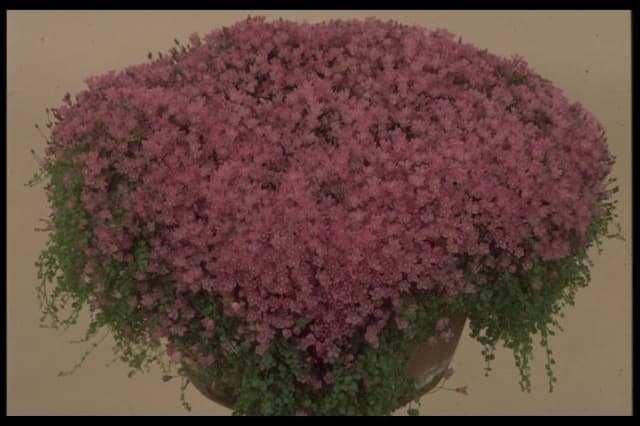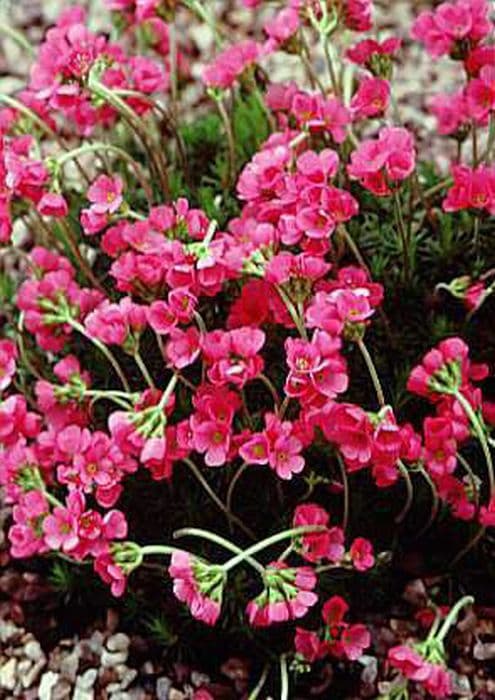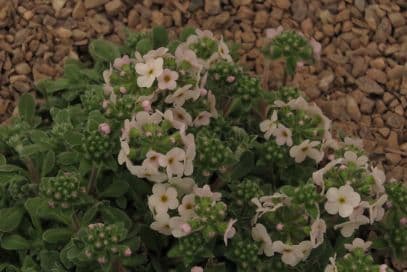Miracle Cyclamen Cyclamen mirabile

ABOUT
Cyclamen mirabile, commonly known as wonder cyclamen, is a beautiful and striking plant famed for its decorative foliage and striking blossoms. The plant's heart-shaped leaves are a canvas of green artistry, featuring intricate patterns with silver and pale green marbling, which provide a stunning backdrop for the flowers. These leaves emerge in a rosette form, gracefully unfurling to showcase their beauty. The flowers of the wonder cyclamen add a romantic, fairy-like charm to the plant. They are characterized by their swept-back petals that resemble tiny, elegant butterflies hovering just above the foliage. The petals come in a delightful range of hues, from soft pinks to rich magentas, often with a darker color at the base which creates a delightful contrast. These blooms rise above the leaves on slender stems, giving the appearance of dainty floating forms in a dance. Adding to the enchantment, wonder cyclamen releases its flowers and leaves from underground tubers, which also serve as storage organs to help it survive periods when it's not actively growing. The effect of the emergence of its ornate features from beneath the soil adds to its mystique and charm among plant enthusiasts. Overall, the wonder cyclamen exudes a sense of delicate beauty through its patterned foliage and graceful flowers, making it a captivating addition to any plant collection or as a seasonal display when it is in its active growing phase.
About this plant
 Names
NamesFamily
Primulaceae.
Synonyms
Miracle Cyclamen, Eastern Sowbread.
Common names
Cyclamen mirabile Tilebarn Nicholas, Cyclamen mirabile Tilebarn Jan, Cyclamen mirabile Hildebrand.
 Characteristics
CharacteristicsLife cycle
Perennials
Foliage type
Deciduous
Color of leaves
Variegated
Flower color
Pink
Height
6 inches (15 cm)
Spread
6 inches (15 cm)
Plant type
Bulb
Hardiness zones
7
Native area
Turkey
Benefits
 General Benefits
General Benefits- Ornamental Appeal: Cyclamen mirabile is admired for its beautiful and variable silver and green patterned heart-shaped leaves, as well as its delicate flowers that come in shades of pink and white.
- Seasonal Interest: It blooms in the autumn, providing color and interest in the garden at a time when many other plants are starting to decline.
- Compact Size: Its small size makes it suitable for growing in pots or rock gardens, and as a front-of-border plant in small garden spaces.
- Attracts Pollinators: The blooms of Cyclamen mirabile can attract butterflies and bees, benefiting the pollination of other plants in the garden.
- Drought Tolerance: Once established, it can tolerate periods of drought, making it a good choice for water-wise gardens.
- Cold Hardy: It is a hardy plant that can survive in cooler temperatures and is capable of withstanding light frosts, making it well-suited for temperate climates.
- Perennial Growth: As a tuberous perennial, it will come back year after year, providing long-term interest in the garden.
- Low Maintenance: Cyclamen mirabile does not require extensive care once established, making it an easy choice for both novice and experienced gardeners.
- Shade Tolerance: It can flourish in partially shaded areas where many other flowering plants may struggle, expanding the options for garden design under trees or in shady corners.
 Medical Properties
Medical PropertiesThis plant is not used for medical purposes.
 Air-purifying Qualities
Air-purifying QualitiesThis plant is not specifically known for air purifying qualities.
 Other Uses
Other Uses- Cyclamen mirabile tubers can be used as a starch substitute if prepared properly to remove toxic elements, providing an emergency food source.
- The crushed leaves of Cyclamen mirabile may be spread in gardens to deter certain pests and insects due to their natural insecticidal properties.
- The plant's decorative foliage can be used in floral arrangements for its aesthetic appeal when the flowers aren't in bloom.
- Extracts from the cyclamen have been used in perfumery to create earthy, green scents, contributing to complex fragrance profiles.
- The patterns and colors of Cyclamen mirabile leaves can be pressed and used in art projects, particularly in creating botanical prints.
- Dried and powdered tubers from Cyclamen mirabile could potentially be used in the craft of natural dyes for fabrics or paper, imparting a subtle color.
- Due to the plant's mesmerizing beauty, it is sometimes used as a living seasonal decoration during its bloom period, especially in autumn.
- Some cultures have used Cyclamen mirabile flowers symbolically in ceremonies to represent love and tenderness, given their heart-shaped leaves and delicate flowers.
- With its attractive foliage, Cyclamen mirabile can be incorporated into educational settings such as schools to teach children about plant lifecycles and horticulture.
- Plant enthusiasts may use Cyclamen mirabile as part of a terrarium or miniature garden setup, adding visual interest with its unique variegated leaves.
Interesting Facts
 Feng Shui
Feng ShuiCyclamen is not used in Feng Shui practice.
 Zodiac Sign Compitability
Zodiac Sign CompitabilityCyclamen is not used in astrology practice.
 Plant Symbolism
Plant Symbolism- Deep love and devotion: Cyclamen mirrors the concept of lasting affection and sincere tenderness, making it popular in displays of love.
- Goodbye: In the language of flowers, giving cyclamen can signify a parting or end of a relationship, symbolizing a respectful farewell.
- Sincerity: Its heartfelt blooms are often used to convey genuine feelings, honesty, and the purity of one's thoughts.
- Motherly love: The nurturing aspect of cyclamen is sometimes associated with a mother's enduring love, care, and compassion.
 Water
WaterCyclamen mirabile, commonly known as Turkish cyclamen, should be watered to keep the soil evenly moist but not waterlogged during its growth phase, which typically lasts from fall to spring. Allow the top inch of soil to dry out before watering again to prevent root rot. This plant may need watering approximately once a week, but this frequency can vary based on room temperature and humidity. Generally, you might use about 8-16 ounces of water each time for a medium-sized pot. During its dormant period in the summer, water sparingly, only enough to prevent the soil from completely drying out.
 Light
LightTurkish cyclamen prefers bright, indirect light away from direct sunlight, which can scorch its leaves. A north- or east-facing window is typically ideal for providing the right light conditions. Ensure that the plant is protected from the intense midday sun but still receives enough light to encourage healthy growth.
 Temperature
TemperatureThe Turkish cyclamen thrives in cooler temperatures and can generally tolerate a range from 40 to 68 degrees Fahrenheit, with an ideal range of 50 to 60 degrees during active growth. It is sensitive to heat, and temperatures consistently above 68 degrees can lead to poor plant health. Keep the plant away from heat sources and drafts to maintain consistent temperature conditions.
 Pruning
PruningPruning Turkish cyclamen is done to remove yellow or withered leaves and spent flowers, which helps to encourage new growth and improves the plant's appearance. Pruning can be done as needed throughout its active growing season. The best time to prune is when you notice parts of the plant that are no longer thriving, which is generally after the flowers have faded.
 Cleaning
CleaningAs needed
 Soil
SoilThe best soil mix for Cyclamen mirabile, also known as the Eastern Sowbread, should be well-draining and rich in organic matter. A mixture of potting soil, perlite, and peat moss in equal parts can provide the right conditions. The soil pH should be slightly acidic to neutral, ranging from 6.0 to 7.0.
 Repotting
RepottingCyclamen mirabile typically needs to be repotted every one to two years. The best time to repot is just after they finish their dormant period, usually in late summer before new growth begins.
 Humidity & Misting
Humidity & MistingCyclamen mirabile requires moderate to high humidity levels to thrive. Aim to maintain humidity around 50-70% for optimal growth.
 Suitable locations
Suitable locationsIndoor
Place in bright, indirect light and keep soil moist but not wet.
Outdoor
Plant in dappled shade, protect from hot sun and extreme weather.
Hardiness zone
7-9 USDA
 Life cycle
Life cycleCyclamen mirabile, commonly known as miraculous cyclamen, begins its life cycle as a seed, which typically germinates in autumn to early winter. Upon germination, a tuber is formed, from which roots and a rosette of leaves develop, enjoying the cool, moist conditions of its preferred Mediterranean climate. The leaves are uniquely patterned and heart-shaped, a distinguishing feature of this plant. Flowering occurs in the autumn, with the plant producing delicate pink or white flowers with an upturned petal shape before the leaves fully develop. Once pollinated, the flowers will give way to seed capsules that are drawn below ground by coiling flower stalks, where they ripen and eventually release the seeds into the soil to start the cycle anew. The plant enters dormancy during the summer when conditions are dry and hot, with the tuber surviving underground until favorable conditions return.
 Propogation
PropogationPropogation time
Autumn
The most popular method for propagating Cyclamen mirabile, commonly known as the tilebarn cyclamen, involves its seeds. You should sow the seeds in the fall, typically after they mature and are collected. The process involves preparing a well-draining soil mix and pressing the seeds into the surface, barely covering them with soil. Maintain a temperature between 59-68 degrees Fahrenheit (15-20 degrees Celsius) which is crucial for germination. It can take up to 30-90 days for the seeds to germinate, and patience is necessary as these plants can be slow to develop. Once seedlings have emerged and are large enough to handle, they can be potted on into individual containers. Seed-raised plants often take several years before they start flowering, so propagation through seeds is a commitment to long-term plant care.









